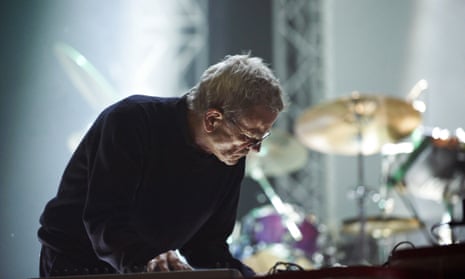Dieter Moebius, who died of cancer on Monday aged 71, was one of the most innovative musicians and composers of our time. He was best known as being half of the great krautrock group Cluster and a third of Harmonia, but his immensely varied and voluminous output spanned inventive collaborations with the late legendary producer Conny Plank, Guru Guru drummer Mani Neumeier, the great musician Asmus Tietchens, and many more. Above all, Moebius’s approach to making music was relentlessly individualistic.
“I was more of the ‘flippy’ one,” he joked when I interviewed him for Frieze in 2012. “Still am. That works a lot with rhythms. ‘Flippy’, that’s German. I guess it means crazy or something.” Here are five great moments from his career.
Cluster – Im Süden (1972)
Cluster emerged from Kluster, an earlier group formed in the late 1960s with the mercurial genius Conrad Schnitzler, who died in 2011. Moebius and fellow Kluster member Hans-Joachim Roedelius soon broke away from Schnitzler to form Cluster, and the chaotic, improvisational Cluster II, their second album under the Cluster moniker, was “still in a way a little bit like the first albums with Schnitzler,” Moebius told me. “But then we got to be more musical, more harmonic.” Im Süden is the crown jewel of Cluster II – 13 minutes of meditative repetition married with focused improvisation and a menacing metal undertow. It was the track that attracted the ear of Michael Rother, the guitarist of Neu!, who soon joined up with Cluster in the pastoral commune of Forst to form Harmonia.
Harmonia – Watussi (1974)
The meditative, rhythmic Watussi is the stunning first song on Harmonia’s debut, Musik von Harmonia, and its apparent simplicity is deceptive; the textures and off-kilter rhythm make the song difficult to cover. The drum machine sounds as if it’s playing underwater, and it showcases the group’s ability to make a lot out of very little gear. Moebius liked tocreatively misuse technology. “To cut it off not in the right places but at the wrong places, so that it was cut and so the rhythm changed totally,” he told me. Moebius, who was trained in graphic design, created the startling Pop Art cover for Musik von Harmonia, along with several other compelling album covers for Cluster and his various collaborations.
Cluster – Caramel (1974)
Caramel was one of the most rock’n’roll songs in Cluster’s oeuvre, and one that dispensed with the usual conventions of a rock’n’roll band – relying instead on an Elka drum machine, an organ and various analogue effects. It was Moebius who wrote Caramel, according to the credits for their album Zuckerzeit. The hummable melody is impossible to forget – one of the highest points on an album packed with high points. In a just world, Zuckerzeit would be played on every classic rock station.
Cluster – In Ewigkeit (1976)
Sowiesoso was Cluster’s most unabashedly gorgeous album – one that, to the listener, best reflected the quietude and lush pastoral atmosphere of Forst, where it was recorded. Moebius, though, was less sentimental. “Well, we were living in the countryside in this house, and we had no money and we were freezing,” he said. “It was not a bad time, but it was not a perfectly good time as well.” In Ewigkeit is Sowiesoso’s dreamy, lightly jazzy closer — so romantic it might border on syrupy if not for Moebius’s cleverly planted electronic noises.
Moebius, Plank, Neumeier – Pitch Control (1983)
Zero Set is a fantastic and utterly mental album, incorporating Conny Plank’s penchant for playing the mixing desk as a musical instrument, Mani Neumeier’s manic, energetic percussion, and Moebius’ “flippy” flair for improvised electronics. “Craziness is something holy,” Plank once proclaimed, and few albums embody that maxim better than Zero Set. All the songs on Zero Set are unmissable but the hard-driving, funky Pitch Control could slot in easily into a current house or techno set.
Moebius and Beerbohm – Doppelschnitt (1984)
Of all the prescient collaborations by Moebius, this alluringly repetitive and endlessly varied 22-minute track holds the mantle for the song that comes closest to proto-techno (doppelschnitt translates as “double cut”). “Beerbohm, who is a Berliner as well, was for a very long time my best friend,” Moebius told me. “He was not a musician, but he listened to a lot of music. He really surprised me.” Gerd Beerbohm played an electronic drum, but one he had to physically hit with a drumstick for 22 minutes, leading to subtle variations in the beat – a fitting pairing for Moebius’s endlessly shifting electronic improvisations.
- This article was amended on 22 July. It incorrectly stated that Cluster II was Cluster’s debut album, instead of their second.

Comments (…)
Sign in or create your Guardian account to join the discussion